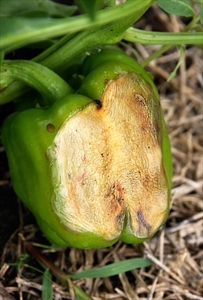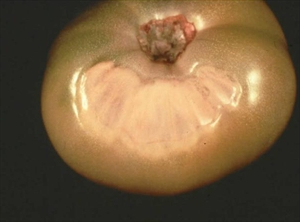Sunscald
Pacific Pests, Pathogens and Weeds - Online edition
Pacific Pests, Pathogens & Weeds
Capsicum sunscald (085)
Sunscald is a 'physiological' problem. It is not caused by insects, fungi, bacteria or other pathogens.
It occurs wherever capsicum and the other susceptible plants are grown.
Capsicum, large red chilli, eggplant, tomato.
Sunscald appears on the side of the fruit suddenly exposed to the sun while it is still green. On capsicum, a white, soft, sunken area develops that later dries out and becomes papery (Photos 1&2). On tomato, the damaged area is white, shiny and blistered, becoming sunken and wrinkled (Photo 3). Symptoms occur on fruits of any size, although maturing fruit tend to be more susceptible to damage.
Sudden exposure of the fruits to sunlight occurs if there are not enough leaves to protect the fruit. This can occur in a number of ways:
- Poor leaf development before flowering.
- Loss of leaves as a results of insect pests (e.g., leafminers) or diseases (many fungal and bacterial diseases).
- Long periods of wilting.
- Broken stems and branches caused by rough handling, especially when harvesting.
- Destruction of leaves by heavy rainfall.
- Plants are not staked properly.
- On tomato, plants have been pruned too severely.
Sunscald occurs when fruit is suddenly exposed to sunlight, especially when it is hot and humid. Affected fruits are unmarketable, but as the damage is only on one side, other parts can still be used in the home. The damage allows fungi and bacteria to enter the fruit and secondary rots may occur. In general, sunscald is not a major problem, but depends on how the crop is cared for, and environmental conditions. These vary.
Look on the exposed sides of mature fruit for sunken areas that are white and papery on capsicum, or white, shiny patches becoming wrinkled on tomato. Look for signs of black fungal growth on the damaged parts.
CULTURAL CONTROL
- Provide sufficient nitrogen for healthy plant growth.
- At least once a week look for signs of insect pests and diseases, which may destroy the canopy of leaves protecting the fruits (see below for recommendations).
- Water regularly in dry weather, to prevent plants from wilting.
- Remove flowers at early stage of development until plants are big enough to support fruit and have enough leaves to provide protection for the fruit.
- Support the plants to minimise damage due to wind and harvesting; this can be done in a number of ways: (i) stakes; (ii) string or (iii) wires running horizontally along the rows.
RESISTANT VARIETIES
No varieties are resistant to sunscald, but there are varieties that have good foliage cover. Select these varieties if sunscald cannot be solved by the cultural controls suggested above.
CHEMICAL CONTROL
Pesticides will not cure plants that show symptoms of sunscald as it is a physiological condition. However, they can prevent the loss of leaves from insect pests and diseases, and if leaves are present they will protect the fruits from sunscald.
The choice of insecticide depends on the insects that are present. The most common insect pests in Pacific island countries are Spodoptera caterpillars and aphids. For these use, Bt - Bacillus thuringiensis var. kurstaki, plant-derived products (e.g., neem, derris, pyrethrum and chilli), or synthetic pyrethroids (see Fact Sheets nos. 31 & 38). Mites are also common on capsicum and on tomato if grown under shade (see Fact Sheet no. 49). For mites, abamectin (a compound from a soil bacterium), derris and sulphur are useful too.
The choice of fungicide depends on the type of disease. Use mancozeb or copper products for fungi causing leaf spots, moulds and blights (see Fact Sheets nos. 45, 76 & 81 ).
____________________
When using a pesticide, always wear protective clothing and follow the instructions on the product label, such as dosage, timing of application, and pre-harvest interval. Recommendations will vary with the crop and system of cultivation. Expert advice on the most appropriate pesticides to use should always be sought from local agricultural authorities.
AUTHORS Suzanne Neave & Grahame Jackson
Information from Cerkauskas R (2004) Sunscald. AVRDC-The World Vegetable Center Fact Sheet. AVRDC Publication 04-583; and from Black LL, Green SK, Hartman GL, Poulos JM (1991) Pepper Diseases: A Field Guide. AVRDC Publication No. 91-347.fhm. 98pp. Photo 2 Missouri botanical Gardens. (http://www.missouribotanicalgarden.org/gardens-gardening/your-garden/help-for-the-home-gardener/advice-tips-resources/pests-and-problems/environmental/sunscald/sunscald-of-tomato-and-peppers.aspx). Photo 3 Stephen M Olson Physiological, nutritional and other disorders of tomato fruit. EDIS. University of Florida, IFAS Extension.
Produced with support from the Australian Centre for International Agricultural Research under project PC/2010/090: Strengthening integrated crop management research in the Pacific Islands in support of sustainable intensification of high-value crop production, implemented by the University of Queensland and the Secretariat of the Pacific Community.







